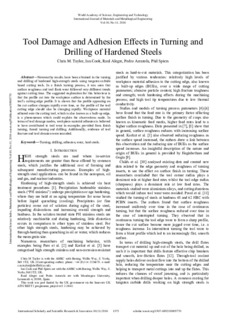| dc.rights.license | Attribution 4.0 International | * |
| dc.contributor.author | ARRAZOLA, PEDRO JOSE | |
| dc.contributor.other | Taylor, Chris M. | |
| dc.contributor.other | Cook, Ian | |
| dc.contributor.other | Alegre García, Raul | |
| dc.contributor.other | Spiers, Phil | |
| dc.date.accessioned | 2022-10-18T15:55:03Z | |
| dc.date.available | 2022-10-18T15:55:03Z | |
| dc.date.issued | 2016 | |
| dc.identifier.issn | 1307-6892 | en |
| dc.identifier.other | https://katalogoa.mondragon.edu/janium-bin/janium_login_opac.pl?find&ficha_no=124725 | en |
| dc.identifier.uri | https://hdl.handle.net/20.500.11984/5753 | |
| dc.description.abstract | Noteworthy results have been obtained in the turning and drilling of hardened high-strength steels using tungsten carbide based cutting tools. In a finish turning process, it was seen that surface roughness and tool flank wear followed very different trends against cutting time. The suggested explanation for this behaviour is that the profile cut into the workpiece surface is determined by the tool’s cutting edge profile. It is shown that the profile appearing on the cut surface changes rapidly over time, so the profile of the tool cutting edge should also be changing rapidly. Workpiece material adhered onto the cutting tool, which is also known as a built-up edge, is a phenomenon which could explain the observations made. In terms of tool damage modes, workpiece material adhesion is believed to have contributed to tool wear in examples provided from finish turning, thread turning and drilling. Additionally, evidence of tool fracture and tool abrasion were recorded. | en |
| dc.description.sponsorship | Gobierno Vasco-Eusko Jaurlaritza | es |
| dc.language.iso | eng | en |
| dc.publisher | World Academy of Science | en |
| dc.rights | © 2016 The Author(s) | en |
| dc.rights.uri | http://creativecommons.org/licenses/by/4.0/ | * |
| dc.subject | Turning | en |
| dc.subject | Drilling | en |
| dc.subject | Adhesion | en |
| dc.subject | Wear | en |
| dc.subject | Hard steels | en |
| dc.title | Tool Damage and Adhesion Effects in Turning and Drilling of Hardened Steels | en |
| dc.type | http://purl.org/coar/resource_type/c_6501 | |
| dcterms.accessRights | http://purl.org/coar/access_right/c_abf2 | en |
| dcterms.source | World Academy of Science, Engineering and Technology, International Journal of Chemical, Molecular, Nuclear, Materials and Metallurgical Engineering. | en |
| local.contributor.group | Mecanizado de alto rendimiento | es |
| local.description.peerreviewed | true | en |
| local.identifier.doi | https://doi.org/10.5281/zenodo.1127384 | en |
| local.relation.projectID | info:eu-repo/grantAgreement/GV/Programa de apoyo a la I+D Empresarial Hazitek 2017/ZL-2017-00221/CAPV/Desarrollo de herramientas de PCBN para la fabricación mediante fresado por torbellino de nuevos husillos/MEKATOR | en |
| local.contributor.otherinstitution | https://ror.org/00fxnmt68 | es |
| local.source.details | Vol. 10. Nº11, 2016 | en |
| oaire.format.mimetype | application/pdf | |
| oaire.file | $DSPACE\assetstore | |
| oaire.resourceType | http://purl.org/coar/resource_type/c_6501 | en |
| oaire.version | http://purl.org/coar/version/c_970fb48d4fbd8a85 | en |








